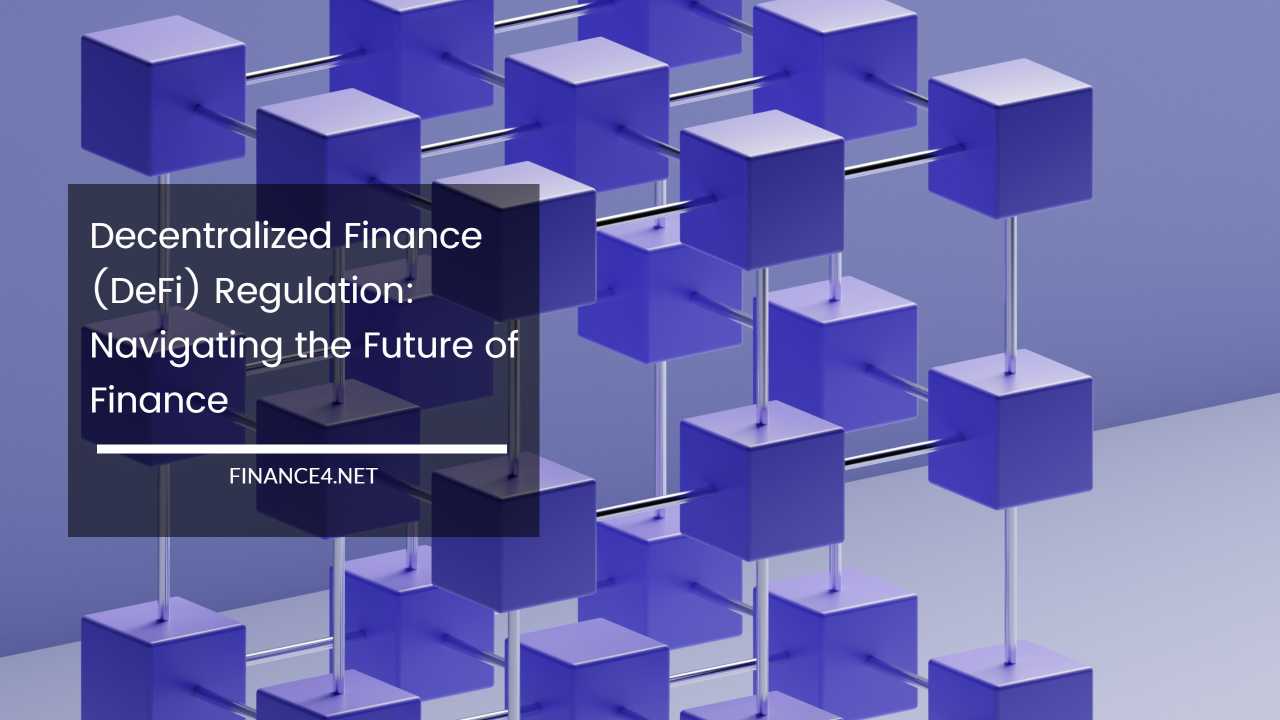Decentralized Finance (DeFi) Regulation: Navigating the Future of Finance

Decentralized Finance
Decentralized Finance (DeFi) has been nothing short of a financial revolution. It has disrupted traditional financial systems and introduced a new paradigm for the world of finance.
However, with its rapid growth and increasing adoption, DeFi has also caught the attention of regulators and policymakers worldwide.
The latest hot topic in the world of finance revolves around how to regulate and govern this burgeoning ecosystem while striking a balance between fostering innovation and ensuring investor protection.
In this comprehensive article, we will delve deep into the world of DeFi regulation, its challenges, responses, and the possible future landscape of DeFi within the regulatory framework.
Understanding DeFi
To comprehend the intricacies of DeFi regulation, it’s essential to first understand what DeFi is and why it has gained such prominence.
Decentralized Finance (DeFi) represents a fundamental shift in the way financial services are created and accessed. At its core, DeFi leverages blockchain technology to build an open, trustless, and permissionless financial ecosystem.
Unlike traditional financial systems that rely on intermediaries such as banks, brokers, and insurance companies, DeFi operates on decentralized applications (dApps) and smart contracts running on blockchain platforms like Ethereum.
Key Components of DeFi
- Smart Contracts: These self-executing contracts with predefined rules are the backbone of DeFi. They automate financial processes, execute transactions, and ensure trustless interactions.
- Decentralized Exchanges (DEXs): DEXs like Uniswap, SushiSwap, and PancakeSwap enable users to trade cryptocurrencies directly without relying on intermediaries. Liquidity providers and liquidity pools play a crucial role in these platforms.
- Lending and Borrowing Platforms: DeFi protocols like Aave, Compound, and MakerDAO allow users to lend their cryptocurrencies and earn interest or borrow assets by providing collateral.
- Stablecoins: These are cryptocurrencies designed to maintain a stable value, often pegged to traditional currencies like the US dollar. USDT, USDC, and DAI are prominent examples and serve as a medium of exchange and store of value within DeFi.
- Decentralized Oracles: Oracles provide real-world data to smart contracts, ensuring they have access to external information. Chainlink is a leading project in this space.
- Asset Management: DeFi protocols like Yearn.finance and Curve.fi offer automated asset management services, optimizing returns for users by allocating funds to the best-performing opportunities.
- Insurance: Projects like Nexus Mutual and Cover Protocol provide decentralized insurance solutions, allowing users to protect their assets against smart contract vulnerabilities and other risks.
Advantages of DeFi
DeFi’s allure lies in its array of advantages, which have propelled its rapid growth:
- Accessibility: DeFi is open to anyone with an internet connection, providing financial services to the unbanked and underbanked populations worldwide.
- Transparency: All transactions and contracts on DeFi platforms are recorded on the blockchain, offering unparalleled transparency and reducing the risk of fraud.
- Lower Costs: DeFi eliminates intermediaries, reducing fees associated with traditional financial services like banking and asset management.
- Innovation: The DeFi space is highly innovative, with new projects and concepts emerging regularly. This fosters competition and drives constant improvement.
- Global Reach: DeFi is borderless, allowing users to access financial services from anywhere in the world without needing to rely on the local financial infrastructure.
- Financial Inclusion: DeFi has the potential to bridge the gap between the financially excluded and the global financial system, offering opportunities to those previously underserved.
Challenges and Risks
While DeFi holds immense promise, it is not without its challenges and risks:
- Smart Contract Vulnerabilities: Bugs or vulnerabilities in smart contracts can lead to significant financial losses. Auditing and security measures are essential but not foolproof.
- Regulatory Uncertainty: DeFi operates in a regulatory gray area in many jurisdictions, leading to uncertainty about legal compliance.
- Market Volatility: Cryptocurrencies are known for their price volatility, which can impact the stability of DeFi protocols and users’ assets.
- Liquidity Risks: Low liquidity in certain DeFi markets can lead to issues like slippage and high trading fees.
- Scams and Hacks: DeFi has been a hotbed for scams and hacks, with bad actors taking advantage of vulnerabilities and exploiting users.
- Privacy Concerns: DeFi’s transparency can be a double-edged sword, as it also exposes users’ transaction histories. Balancing transparency and privacy is a challenge.
- Centralization Risks: Despite being labeled as “decentralized,” some DeFi projects still exhibit centralized elements, such as governance control by a small group of entities.
The Regulatory Landscape of DeFi
Regulators and policymakers worldwide are grappling with the unique features and challenges posed by DeFi.
The global nature of DeFi presents a significant challenge for regulators, as it transcends traditional jurisdictional boundaries. Here, we examine how various jurisdictions are approaching DeFi regulation.
United States
The United States is actively exploring regulatory approaches to DeFi. The U.S. Securities and Exchange Commission (SEC) has been vocal about the need for DeFi platforms to adhere to securities regulations.
Projects offering tokens that are deemed securities may be subject to registration and disclosure requirements.
Moreover, proposals and bills have been introduced in Congress to address various aspects of the crypto and DeFi space. These include proposals to define digital assets and establish a regulatory framework for stablecoins.
European Union
In the European Union (EU), regulators are working on a comprehensive framework for crypto assets, including DeFi platforms.
The Markets in Crypto Assets (MiCA) proposal aims to create a clear regulatory framework for digital assets, which includes requirements related to authorization, governance, and investor protection.
China
China has been at the forefront of central bank digital currency (CBDC) development, an area closely related to DeFi. While CBDCs represent a different concept from DeFi, they do play a role in the broader discussion about the future of digital finance.
International Cooperation
Given the global nature of DeFi, international cooperation is essential for effective regulation.
Organizations like the Financial Stability Board (FSB) and the International Organization of Securities Commissions (IOSCO) are actively involved in discussions and initiatives related to DeFi and digital assets.
These organizations aim to establish common standards and guidelines that can be applied globally.
The Regulatory Challenges of DeFi
The regulation of DeFi presents a unique set of challenges, which regulators must address as they navigate this evolving landscape:
1. Lack of Physical Presence
DeFi protocols often operate in a completely decentralized manner, without a physical office or jurisdiction. This makes it challenging for regulators to identify and hold accountable the individuals or entities responsible for these protocols.
2. Cross-Border Nature
DeFi is inherently borderless. Transactions occur globally, making it difficult for individual jurisdictions to enforce regulations effectively. International cooperation and coordination are essential to regulate this global ecosystem.
3. Smart Contract Auditing
Ensuring the security and reliability of smart contracts used in DeFi is a complex task. Regulators may need to establish auditing standards or require third-party audits to reduce the risk of vulnerabilities and exploits.
4. Regulatory Arbitrage
Regulatory arbitrage occurs when DeFi projects move to jurisdictions with more favorable regulatory environments. Regulators must address this issue to prevent projects from evading necessary oversight.
5. Privacy and Anonymity
Balancing privacy and transparency is a challenge. Regulators need to strike the right balance between preventing illicit activities and respecting user privacy.
6. Innovation vs. Regulation
Regulators must foster innovation in the DeFi space while protecting investors and maintaining financial stability. Striking the right balance between these objectives is crucial.
7. Regulatory Framework Consistency
Harmonizing DeFi regulations across different jurisdictions is a significant challenge. Inconsistencies in regulations can lead to regulatory arbitrage and hinder global cooperation.
Regulatory Responses to DeFi
As DeFi continues to evolve, regulators and policymakers have initiated various responses to address the challenges and risks associated with this decentralized ecosystem:
1. Study and Understanding
Many regulators are actively studying DeFi to better understand its mechanics, risks, and potential benefits. These studies serve as the foundation for future regulatory actions.
2. Enforcement Actions
Regulators have initiated enforcement actions against projects and individuals involved in fraudulent or non-compliant DeFi activities. This serves as a deterrent to bad actors in the space.
3. Clarification of Existing Laws
Some jurisdictions have provided guidance on how existing financial regulations apply to DeFi. These clarifications help DeFi projects understand their compliance requirements.
4. New Legislation and Frameworks
In response to the unique challenges of DeFi, some countries are considering or implementing new legislation to specifically address digital assets and decentralized finance. These frameworks aim to provide regulatory clarity.
5. International Collaboration
Given the cross-border nature of DeFi, international cooperation is paramount. Regulators worldwide are collaborating to establish common standards and guidelines for the industry.
6. Industry Self-Regulation
Some DeFi projects and industry participants are taking proactive steps to self-regulate. This includes implementing standards, best practices, and audits to enhance security and compliance.
The Future Landscape of DeFi Regulation
The future landscape of DeFi regulation will likely involve a combination of approaches as regulators seek to address the challenges while preserving the innovative potential of the ecosystem:
1. Balancing Innovation and Regulation
Regulators recognize the need to strike a balance between fostering innovation and ensuring investor protection. Striking this balance is essential to prevent stifling innovation while addressing systemic risks.
2. DeFi Self-Regulation
As DeFi projects mature, they may increasingly adopt self-regulatory measures, similar to traditional financial institutions. These measures could include industry standards, best practices, and audits.
3. Hybrid Regulatory Approaches
DeFi may evolve within a regulatory framework where some aspects are regulated, while others remain decentralized and outside the purview of traditional authorities. This hybrid approach aims to provide investor protection while allowing innovation to flourish.
4. Global Cooperation and Standardization
Regulators worldwide will need to collaborate to establish consistent regulatory frameworks. This includes harmonizing definitions, regulations, and enforcement efforts.
5. Continued Innovation
Innovations in DeFi will continue to emerge, challenging regulators to adapt and respond effectively. Regulators must remain agile to address new risks and opportunities.
6. Education and Awareness
As regulations evolve, there will be a need for education and awareness campaigns to help DeFi users and industry stakeholders understand compliance requirements and risks.
Final Remarks
Decentralized Finance (DeFi) represents a groundbreaking shift in the world of finance, offering new opportunities for financial inclusion, transparency, and innovation.
However, it also presents unique challenges and risks that regulators and policymakers must address. The regulatory landscape of DeFi is still taking shape, and it is a dynamic and evolving field.
The future of DeFi regulation will be shaped by the collaborative efforts of regulators, industry participants, and the broader crypto community.
Striking the right balance between innovation and regulation is the key to unlocking the full potential of DeFi while safeguarding users and the financial system.
As DeFi continues to mature and expand, it is essential for all stakeholders to engage in constructive dialogue and cooperation to ensure that this transformative technology benefits society while mitigating potential abuses.
The regulatory path forward may be complex, but with careful consideration and collaboration, the world of decentralized finance can thrive within a regulatory framework that promotes trust, security, and innovation.



